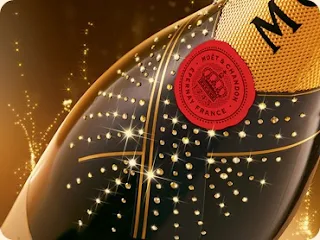Although sparkling wine is produced around the world, Champagne is produced exclusively in France. The Champagne region is the most northern winemaking region in France and is located about an hour and a half northeast of Paris. Occasionally you will see wines produced outside France, especially in the US and Australia, labeled as “Champagne” to help with the marketing. These are usually lower quality wines that should be labeled as sparkling wine. Only 10% of the world’s sparkling wine is truly Champagne.
There are three main grapes used in the production of Champagne: Pinot Noir, Pinot Meunier and Chardonnay. These grapes (and occasionally others) are blended to create complex wines in bottles of extra thick glass designed to handle the pressure from the carbon dioxide in the wine. That’s one reason why Champagne is more expensive than regular wine. We don’t need an exploding bottle to liven up the party.
Authentic Champagne is bottled using what is called the traditional method (also called the Classic or Champagne method). You may see the term Methode Traditionelle on the label. This method produces a smooth and creamy wine with smaller bubbles.
There are two fermentations: The first converts the grape juice into wine. The fermentation is done separately with wines from different vineyards and vintages. In the second step, the Champagne producer blends the various wines in order to provide a consistent product. A winemaker can blend from 20 to 100 different wines to get just the right taste.
The second fermentation is in the bottle and it is then that the sparkling aspect of the wine is produced. This can take one to three years or more. While the first fermentation takes place in open containers (allowing the carbon dioxide to escape) the second in-bottle fermentation traps the gas and creates the famous Champagne bubbles. During the aging process natural sediment from the bottle is removed (after the top of the bottle is frozen).
Most Champagne you see is non-vintage (grapes not from one particular year). In still wine, NV can mean an inferior product. Not so with Champagne. Vintage Champagne is produced using grapes entirely of a single year – but this only happens when the winemaker feel the grapes are exceptional. In a decade, a normal producer might have only three vintage years. This Champagne is fuller, creamier and more expensive than NV. The top of the Champagne ladder is the Prestige Cuvee Champagne, which is made only in small quantities from a single exceptional vintage. This is the most expensive, highest-quality Champagne there is.
We hope we’ve whet your whistle for some bubbly. Here are a few closing tips: 1) Hold the cork and gently twist the bottle to uncork. You should hear a hiss or sigh rather than a loud pop, 2) Traditionally, Champagne is poured using one hand. Place your thumb in the hollow of the bottle at the bottom and spread your fingers around the base, 3) Pour only a small amount of Champagne at first. After the wine settles, fill the glass two-thirds full.


No comments:
Post a Comment